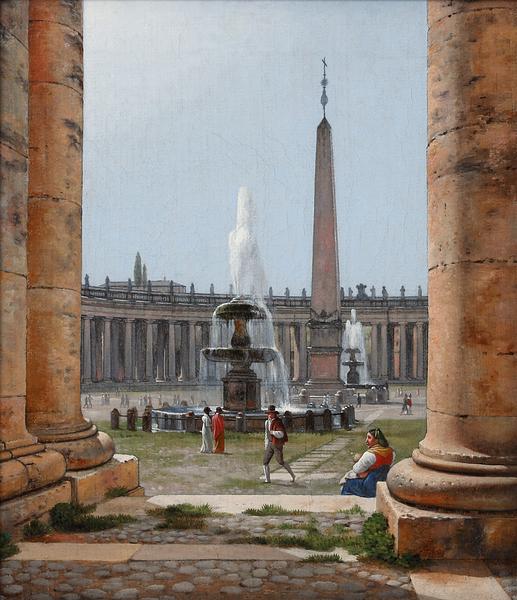C.W. Eckersberg left Paris at the beginning of June 1813 and reached his next destination – Rome – early the following month. He now found himself part of an international scene where artists from many different countries had begun to inspire each other to carry out a comprehensive renewal of landscape painting.
[1] In a crucial artistic renewal, artists began to paint out of doors, directly in front of their subject matter – instead of, as had previously been the case, doing only drawing outdoors while all painting happened inside the studio.
After just a few months in Rome, Eckersberg saw the benefits of
plein air painting and began to paint a series of prospects of Roman buildings, areas and streets. These pictures were small and seemingly unambitious in terms of their quite anonymous subjects. Eckersberg rarely painted the city's well-known sights or its most famous monuments. When he occasionally did so, he chose carefully cropped sections of his subject, always adopting a surprising point of view.
At St. Peter’s Square, Eckersberg did not turn his eye towards the impressive facade with the enormous dome of the world’s largest and most famous church, St. Peter’s Basilica. Instead, he chose a more modest subject, focusing on the colonnade by G.L. Bernini which surrounds the square. Eckersberg’s choice of position and point of view is quite striking. He has positioned himself
in the colonnade, between the columns, his gaze directed to the north so that the large obelisk with the two fountains on either side is seen in a diagonal line that runs from the column on the left in the foreground of the picture. The artist was clearly attracted to the basic architectural elements found here even as he painstakingly reproduced all the many details and colours, the sunlight and shadows.
Eckersberg did three versions of
View of the Colonnade, St. Peter’s Square. However, determining the proper sequence and dating of the three versions is difficult. The famous Danish sculptor Bertel Thorvaldsen presumably acquired one of the paintings during the years 1813–1816 when Eckersberg was in Rome.
[2] Another version now belongs to Ordrupgaard.
[3] The version in The David Collection is the painting that Eckersberg himself kept and which was later sold at his estate auction in 1853.
[4]
Inv. no. 19/1969
Published in:
Fortegnelse over en Samling af Malerier, Tegninger og Kobbere, udstillet af Selskabet Konstforeningen, Kjöbenhavn 1828, no. 162; Fortegnelse over en Samling af Malerier, Skizzer og Haandtegninger, tilhørende Boet efter afgangne Professor ved Kunstacademiet C. W. Eckersberg … Auction …17de Januar 1854, Kunstforeningen, København 1853, no. 15, p. 3;Philip Weilbach: Maleren Eckersbergs Levned og Værker, København 1872, pp. 223-224;Udstillingen af C.W. Eckersberg’s Malerier i Kunstforeningen, Oktober-November 1895, København 1895, cat. 109;Emil Hannover: Maleren C.W. Eckersberg: En Studie i dansk Kunsthistorie, Kunstforeningen, København 1898, cat. 200; V. Winkel & Magnussen (ed.): Kunst i privat eje, vol. 1, København 1944, fig. 10, pp. 142-143; Vagn Poulsen: ”Guldalderbilleder” in C.L. Davids Samling. Fjerde del, Jubilæumsskrift 1945-1970, København 1970, p. 22, no. 2, p. 27; Dansk kunst og kunsthåndværk, Davids Samling, København 1972, p. 10 and planche 5; Henrik Bramsen and Hannemarie Ragn Jensen (eds.): ”Eckersbergs brevkoncepter 1813-16”, Meddelelser fra Thorvaldsens Museum, København 1973, fig. 35, p. 121;Verner Jul Andersen: Dansk kunst og kunsthåndværk, Davids Samling, 2. ed., København 1983, cat. 415 and ill. V; Dyveke Helsted, Eva Henschen and Bjarne Jørnæs: C.W. Eckersberg i Rom 1813-16, Thorvaldsens Museum, København 1983, fig. 8, pp. 42-43 and cat. 25, p. 101; Kasper Monrad in L’âge d’or de la peinture danoise 1800-1850, Grand Palais, Paris 1984, p. 142; Torsten Gunnarsson: Friluftsmåleri före friluftsmåleriet. Oljestudien i nordiskt landskapsmåleri 1800-1850 = Open-air oil sketching in Scandinavia 1800-1850 : with a survey of the development of the landscape oil sketch in Europe, c. 1630-1850, Uppsala 1989, p. 95, ill. 71; Hans Edvard Nørregaard-Nielsen: Dengang i Italien: H.C. Andersen og guldaldermalerne, Statens Museum for Kunst, København 2005, pp. 272-273;Peter Michael Hornung and Kasper Monrad: C.W. Eckersberg – dansk malerkunsts fader, København 2005, pp. 152-153; Jesper Svenningsen: C.W. Eckersberg. Værker fra Kunstmuseet Brundlund Slot, Aabenraa 2017, p. 37;
